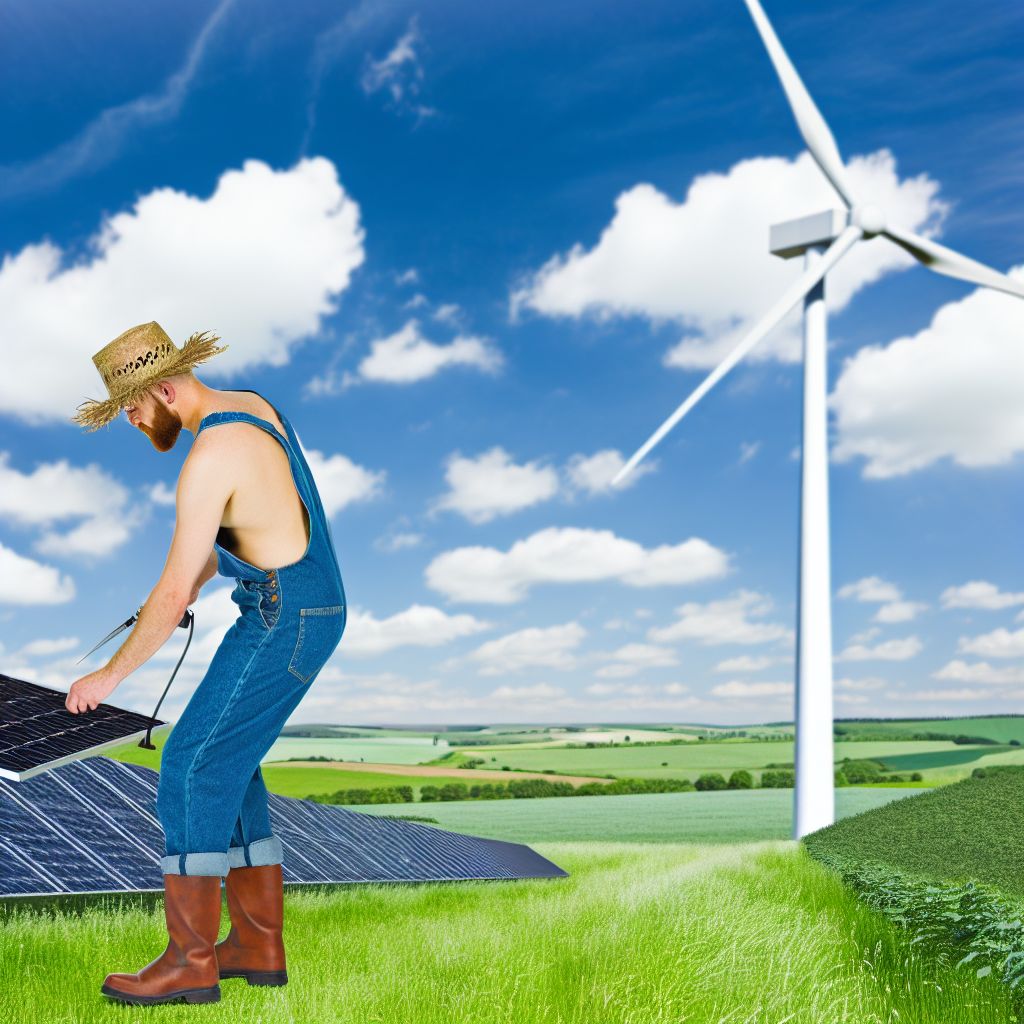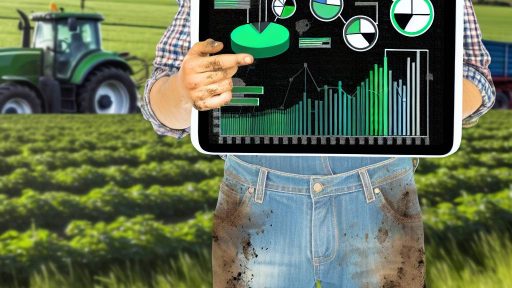Introduction to Renewable Energy in Sustainable Farming
Renewable energy plays a crucial role in sustainable farming.
Farmers increasingly adopt renewable sources to minimize environmental impact.
This transition supports an eco-friendly and efficient agricultural system.
Benefits of Renewable Energy
Utilizing renewable energy reduces greenhouse gas emissions.
Additionally, it promotes energy independence for farmers.
Farmers can lower operational costs through renewable solutions.
Solar and wind energy options offer significant savings over time.
Types of Renewable Energy Sources
- Solar power harnesses sunlight through solar panels.
- Wind energy captures wind movement with turbines.
- Biomass energy leverages organic materials for fuel.
- Hydropower generates energy from flowing water sources.
Implementing Renewable Energy Practices
Farmers can incorporate renewable energy in various ways.
Installing solar panels on barns is a popular choice.
Moreover, wind turbines can be placed on open land for electricity generation.
Utilizing anaerobic digesters for biomass conversion enhances sustainability.
Case Studies of Successful Implementation
Harrington Farms successfully integrated solar energy in their operations.
They observed a 30% decrease in energy costs after installation.
Green Valley Ranch utilizes wind turbines to power irrigation systems.
As a result, they significantly minimized their carbon footprint.
Transform Your Agribusiness
Unlock your farm's potential with expert advice tailored to your needs. Get actionable steps that drive real results.
Get StartedChallenges and Considerations
Transitioning to renewable energy poses certain challenges.
Initial costs for installation can be a barrier for some farmers.
However, government incentives often help mitigate these expenses.
Additionally, farmers must consider energy storage solutions.
Future Trends in Renewable Energy and Farming
The future of renewable energy in farming looks promising.
Emerging technologies continue to enhance efficiency and affordability.
Moreover, collaborative efforts between farmers and energy companies are increasing.
This trend fosters innovation and sustainable practices across the industry.
Overview of Renewable Energy Sources Suitable for Agriculture
Solar Energy
Farmers can harness solar energy effectively.
Photovoltaic panels convert sunlight into electricity.
This energy powers irrigation systems and barns.
Additionally, solar heaters can support greenhouse operations.
Overall, solar energy reduces reliance on fossil fuels.
Wind Energy
Wind energy is another viable option for farmers.
Tall wind turbines generate electricity from wind currents.
Installing wind turbines can significantly lower energy costs.
Moreover, wind farms can create additional revenue streams.
Farmers must assess wind patterns and land use carefully.
Biomass Energy
Biomass energy derives from organic materials.
Crop residues and animal manure serve as excellent sources.
This energy can power machinery and heating systems.
Farmers can convert waste into valuable energy.
Additionally, biomass reduces greenhouse gas emissions.
Geothermal Energy
Geothermal energy utilizes heat from the earth’s core.
Showcase Your Farming Business
Publish your professional farming services profile on our blog for a one-time fee of $200 and reach a dedicated audience of farmers and agribusiness owners.
Publish Your ProfileThis renewable source can warm greenhouses effectively.
It also provides hot water for various agricultural processes.
Farmers benefit from stable and sustainable heating solutions.
Overall, geothermal energy enhances energy independence.
Hydropower
Hydropower harnesses energy from flowing water.
Farmers with access to rivers can generate electricity.
Small-scale hydropower systems are particularly effective.
These systems can power irrigation pumps and barns.
Hydropower reduces costs and boosts sustainability.
Benefits of Implementing Renewable Energy in Farming Practices
Cost Savings
Integrating renewable energy can significantly reduce operational costs for farmers.
For example, solar panels can lower electricity bills over time.
Additionally, farmers can benefit from government incentives and tax credits.
These savings can be reinvested into farm operations.
Environmental Sustainability
Renewable energy sources promote environmental stewardship.
They reduce greenhouse gas emissions compared to fossil fuels.
This leads to a healthier ecosystem and improved air quality.
Moreover, sustainable practices help conserve natural resources.
Energy Independence
Renewable energy enhances energy security for farming operations.
Farmers become less reliant on fluctuating fossil fuel markets.
This independence allows for better long-term planning.
Additionally, it can stabilize production costs.
Improved Resilience
Renewable energy systems contribute to farm resilience.
They ensure a reliable energy supply during outages.
Furthermore, these systems can adapt to changing weather patterns.
This adaptability supports consistent farm operations.
Access to New Markets
Implementing renewable energy can open new market opportunities.
There is a growing demand for sustainably produced goods.
Consumers increasingly prioritize eco-friendly products.
By showcasing renewable energy use, farmers can enhance their brand image.
Community Benefits
Using renewable energy can strengthen local communities.
It creates jobs in the green energy sector.
Moreover, it can inspire other farmers to adopt sustainable practices.
Community support grows when farms prioritize environmental responsibility.
Gain More Insights: Enhancing Crop Protection Through Innovative Strategies
Case Studies: Successful Renewable Energy Solutions in Farms
Solar Energy on Vineyards
Blue Sky Vineyards equips its fields with solar panels.
This setup powers irrigation systems effectively.
Moreover, excess energy sells back to the grid.
As a result, the vineyard lowers operational costs.
Wind Power in Grain Farms
Green Grain Farms utilizes wind turbines to generate energy.
These turbines provide a steady power supply throughout the year.
Showcase Your Farming Business
Publish your professional farming services profile on our blog for a one-time fee of $200 and reach a dedicated audience of farmers and agribusiness owners.
Publish Your ProfileConsequently, energy independence improves farm sustainability.
Farmers also report lower utility bills.
Biogas Production from Livestock Waste
Happy Cattle Ranch transforms manure into biogas.
This biogas fuels heating systems and farm vehicles.
By doing so, the ranch reduces greenhouse gas emissions.
Additionally, the process produces organic fertilizer.
This solution enhances soil health and crop yields.
Geothermal Heating in Greenhouses
Sunny Greenhouse Co. uses geothermal energy for heating.
This system maintains ideal conditions for plant growth.
It significantly reduces fossil fuel dependency.
Furthermore, the farm enjoys a longer growing season.
Community Solar Initiatives
Farmers in Harmony Valley participate in community solar projects.
These collective efforts reduce installation costs for solar panels.
Each farmer benefits from the shared energy production.
Importantly, this promotes local engagement and support.
Explore Further: Maximizing Profits Through Efficient Farm Financial Management Practices
Challenges and Barriers to Adopting Renewable Energy in Agriculture
High Initial Costs
The transition to renewable energy often requires high upfront investments.
Farmers may struggle to find funding for solar or wind energy systems.
Moreover, many renewable technologies are still relatively expensive.
This investment can seem daunting for small-scale farmers.
Limited Access to Technology
Access to advanced renewable energy technologies remains uneven.
Some farmers lack the technical skills to install and maintain new systems.
Additionally, rural areas sometimes face inadequate infrastructure.
This leads to a digital divide that hampers technology adoption.
Regulatory Challenges
Farmers often face complex regulations regarding renewable energy use.
Compliance can be time-consuming and difficult to navigate.
Furthermore, varying state incentives create uncertainty in investments.
This inconsistency can discourage potential adopters.
Market Limitations
The market for renewable energies can fluctuate unpredictably.
Prices for energy can vary widely, impacting farmers’ financial planning.
Moreover, the demand for renewable energy credits is not always stable.
This uncertainty complicates long-term investment strategies.
Lack of Awareness and Education
Many farmers remain unaware of the benefits of renewable energy.
Current educational resources about these technologies are often limited.
To address this, extension services must expand their outreach.
Educational programs can empower farmers with knowledge and skills.
Cultural Resistance
Some farmers may resist changing traditional practices.
They often prefer established methods over adopting new technologies.
To overcome this, success stories and peer networks are essential.
Sharing positive experiences can help shift perspectives.
Showcase Your Farming Business
Publish your professional farming services profile on our blog for a one-time fee of $200 and reach a dedicated audience of farmers and agribusiness owners.
Publish Your ProfileLearn More: Integrating Precision Agriculture for Sustainable Farm Management

Technological Innovations in Renewable Energy for Farming
Solar Energy Systems
Solar panels capture sunlight and convert it into electricity.
Farmers use solar energy to power irrigation systems and barns.
Additionally, solar energy reduces reliance on fossil fuels.
Farm operations become more cost-effective through energy savings.
Wind Energy Solutions
Wind turbines harness wind power to generate electricity.
Farmers can install turbines on their land to produce energy.
This technology provides a sustainable alternative to grid electricity.
Wind energy also contributes to reducing greenhouse gas emissions.
Biogas Production
Biogas systems convert organic waste into usable energy.
Farmers can utilize livestock waste to produce biogas.
This biogas serves as a renewable source of heating and electricity.
Consequently, waste management is effectively minimized.
Hydroponic Systems
Hydroponics utilize water and nutrient solutions for plant growth.
These systems require less land and reduce water usage significantly.
Solar-powered hydroponic systems optimize energy use in farming.
As a result, they enhance food production in urban areas.
Agricultural Robotics
Agricultural robots automate tasks like planting and harvesting crops.
These machines improve efficiency and reduce labor costs.
Robotics combined with renewable energy boosts sustainability in farming.
Farmers can deploy energy-efficient robots for various applications.
Smart Farming Technologies
Smart farming leverages IoT devices for real-time data collection.
This technology monitors soil health, weather patterns, and crop conditions.
By utilizing renewable energy, these technologies become more sustainable.
Farmers access data that helps optimize resource use and yields.
Uncover the Details: Renewable Energy Solutions for Diversified Farms
Government Policies and Incentives for Renewable Energy Adoption in Agriculture
Overview of Renewable Energy Policies
Government policies play a crucial role in promoting renewable energy.
Several initiatives encourage the adoption of sustainable practices.
These policies target various aspects of agricultural production.
Federal Incentives for Farmers
The federal government provides numerous incentives for farmers.
Tax credits encourage the investment in renewable energy technology.
Farmers may qualify for grants to implement solar and wind energy systems.
Moreover, loan programs assist in financing renewable energy projects.
State-Level Programs
States also offer specific programs to support renewable energy adoption.
For instance, California provides incentives for solar energy utilization.
Similarly, Texas has initiatives focused on wind energy development.
State agencies often collaborate with local farmers to implement these programs.
Environmental Benefits
Renewable energy policies lead to significant environmental benefits.
These practices reduce greenhouse gas emissions in the agricultural sector.
Additionally, they improve local air and water quality.
Showcase Your Farming Business
Publish your professional farming services profile on our blog for a one-time fee of $200 and reach a dedicated audience of farmers and agribusiness owners.
Publish Your ProfileIncorporating renewable energy enhances biodiversity on farms.
Challenges and Considerations
Despite incentives, challenges remain for farmers adopting renewable energy.
Initial costs can be a significant barrier for many agricultural operations.
Additionally, farmers may require technical assistance to implement systems.
Ongoing education is vital for ensuring successful adoption.
Future Directions
Future policies are likely to expand support for renewable energy in agriculture.
Increased federal funding could bolster existing programs.
Research initiatives may focus on innovative technologies for farming.
Furthermore, collaboration among farmers, government, and researchers is essential.
Future Trends and Perspectives on Renewable Energy in Sustainable Farming
Adoption of Innovative Technologies
Farmers increasingly embrace innovative technologies in renewable energy.
For instance, solar panels transform agricultural fields into energy producers.
Wind turbines on farms generate electricity, reducing reliance on fossil fuels.
Moreover, smart grid technologies optimize energy usage on farms.
These advancements foster significant operational efficiencies.
Integration of Renewable Sources
Renewable energy sources blend seamlessly into sustainable farming practices.
Bioenergy from agricultural waste powers various farm operations.
Geothermal energy offers heating solutions for greenhouses and livestock facilities.
Additionally, hydropower systems can be employed in irrigation processes.
Such integrations enhance overall sustainability and productivity.
Government Policies and Incentives
Supportive government policies drive the adoption of renewable energy.
Subsidies encourage farmers to invest in renewable technologies.
Tax credits for solar and wind installations make them more accessible.
Regulations that promote energy efficiency also play a crucial role.
Consequently, farmers are more likely to pursue renewable options.
Consumer Demand for Sustainability
Consumer demand increasingly favors sustainably produced food.
As a result, farmers must adapt to meet these preferences.
Using renewable energy contributes to a farm’s eco-friendly image.
This shift can boost market competitiveness and profitability.
Additionally, consumers are willing to pay more for sustainable products.
Global Collaboration and Knowledge Sharing
Farmers and researchers collaborate globally to share best practices.
Knowledge sharing accelerates the adoption of renewable energy solutions.
International conferences showcase successful case studies in farming.
These exchanges inspire innovation and improvement in local practices.
Ultimately, collaboration enhances the sustainability of global agriculture.
Additional Resources
USDA Strategic Plan Fiscal Years 2022-2026
Natural Resources and Sustainable Agricultural Systems : USDA ARS




